 |
 |
 |
| |
D-dimer Levels Correlate with
Inflammatory and Endothelial Activation Markers in HIV-infected Adults
|
| |
| |
Reported by Jules Levin
CROI 2011 Feb 27-March 2 Boston
Caryn Morse1, Amanda Jichlinski1, Mary McLaughlin1, Adam Rupert2, Randy Stevens2, Ann Cullinane3, Khanh Ngheim3, Michael Proschan4, Jay Lozier3, Joseph Kovacs3 Laboratory of Immunoregulation, NIAID, Bethesda, MD1, SAIC-Frederick, Frederick, MD2, NIH Clinical Center3, NIAID BIostatistics4, Bethesda, MD
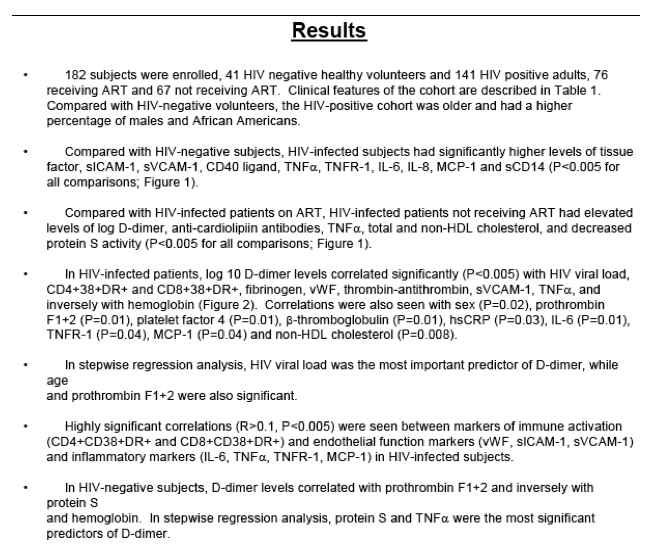
Conclusions
These findings suggest that HIV plays an important role in D-dimer elevation through induction of inflammation and endothelial activation, which may be mediated in part by TNFa released following monocytes/macrophage activation. Further studies in longitudinal cohorts are needed to better understand the mechanisms leading to persistent elevation of a subset of biomarkers despite effective ART. Therapies that reduce the inflammatory response to HIV and decrease specific biomarkers such as D-dimer, IL-6, or TNFα, should be studied as potential interventions to reduce the risk of morbidity and death in HIV-infected individuals.
Introduction
In HIV-infected patients, elevated levels of inflammatory and coagulation biomarkers have been associated with risk of disease progression, immune reconstitution inflammatory syndrome, and all-cause mortality. The pathophysiology resulting in the association between elevated biomarkers and mortality in HIV is not well understood. The vascular endothelium, a regulatory organ that participates in hemostasis, inflammation, immune responses, and other processes, plays a role in the control of several biomarkers. Increased expression of adhesion molecules and inflammatory cytokines involved in the recruitment and adhesion of leukocytes at endothelial sites of atheroma formation, including tumor necrosis factor α (TNFα), interleukin-6 (IL-6), soluble vascular cell adhesion molecule-1 (sVCAM-1), monocyte chemoattractant protein-1 (MCP-1) and von Willebrand factor (vWF), has been reported in HIV infection. Endothelial dysfunction, a marker of atherosclerosis predictive of cardiovascular events, may result in impaired coagulation and fibrinolysis and has been associated with both HIV infection and antiretroviral therapy.
The objective of this study is to further investigate the correlation between markers of coagulation, platelet function, inflammation, and endothelial cell function, and clinical parameters in a cohort of HIV-infected adult outpatients. Comparisons are made between patients with HIV viremia, patients with HIV viral suppression on ART, and a control cohort of HIV negative participants. The cross-sectional results for the first 181 enrolled subjects are reported here.
Abstract
Background: Biomarkers of inflammation and coagulation, especially D-dimer, but also interleukin-6 (IL-6) and C-reactive protein (CRP), have recently been shown to predict all-cause mortality in HIV-infected adults. To better understand the potential mechanisms leading to D-dimer elevation in this population, we examined the relationship between D-dimer and a broad panel of inflammatory and coagulation biomarkers and select clinical parameters in a cohort of HIV-infected adults.
Methods: Biomarkers of coagulation (including D-dimer, prothrombin fragment 1 and 2 (F1+2), and fibrinogen), inflammation (including high-sensitivity CRP, IL-6, tumor necrosis factor alpha (TNFa)) and endothelial function (including von Willebrand factor (vWF), soluble intracellular adhesion molecule-1 (sICAM-1) and soluble vascular adhesion molecule-1 (sVCAM-1)) were measured prospectively in a cohort of HIV infected adults (n=141) and HIV-negative controls (n=41). Spearman correlations between D-dimer and the other biomarkers were determined. T-tests were performed to look at differences in biomarker levels between patient groups and controls.
Results: In HIV-infected patients, D-dimer levels correlated significantly (P<0.005) with HIV viral load, TNFa, sVCAM-1, prothrombin F1+2, vWF, IL-6, and IL-10, and inversely with hemoglobin. In stepwise regression analysis, HIV viral load was the single most important predictor of D-dimer, while age and prothrombin F1+2 also remained significant. Compared with HIV- negative controls, sICAM-1, sVCAM-1, TNFa, IL-6 and tissue factor were significantly elevated in HIV-infected patients overall and in the subsets of patients on or off of antiretroviral therapy (ART). D-dimer, sVCAM-1 and TNFa were significantly higher in HIV-infected patients off of ART compared to those on ART (P<0.01 for all comparisons).
Conclusions: These findings suggest that HIV plays an important role in D-dimer elevation through induction of inflammation and endothelial activation, which may be mediated in part by TNFa released following monocytes/macrophage activation. Further studies are needed to better understand the mechanisms leading to persistent elevation of a subset of biomarkers despite effective ART.
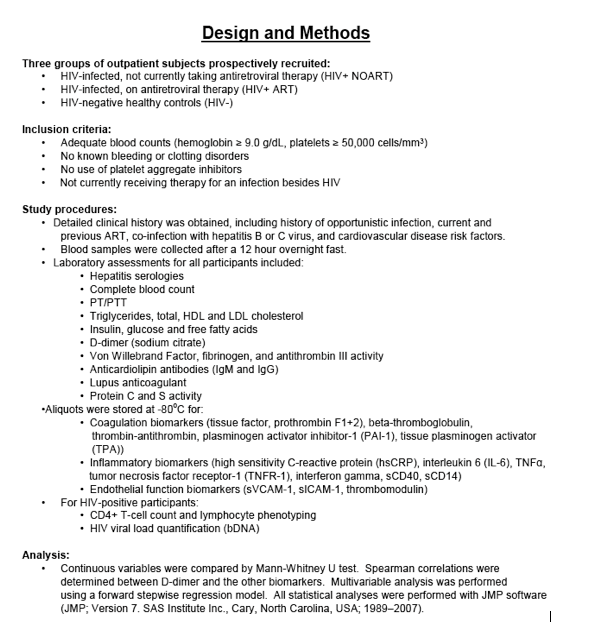
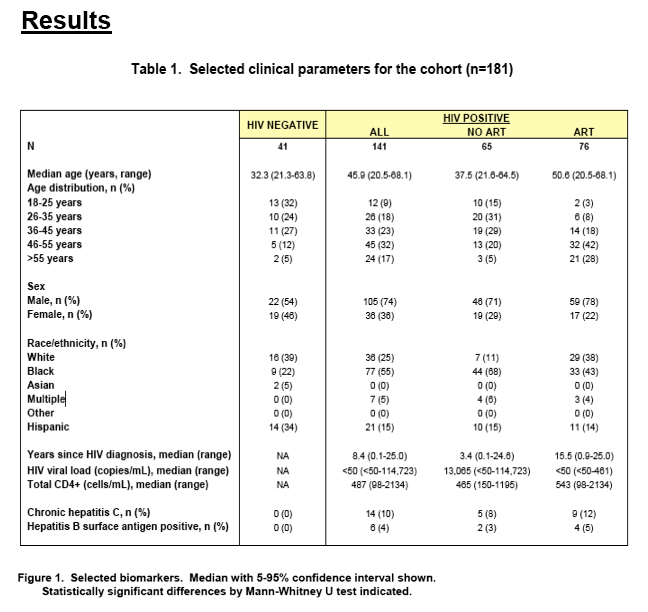
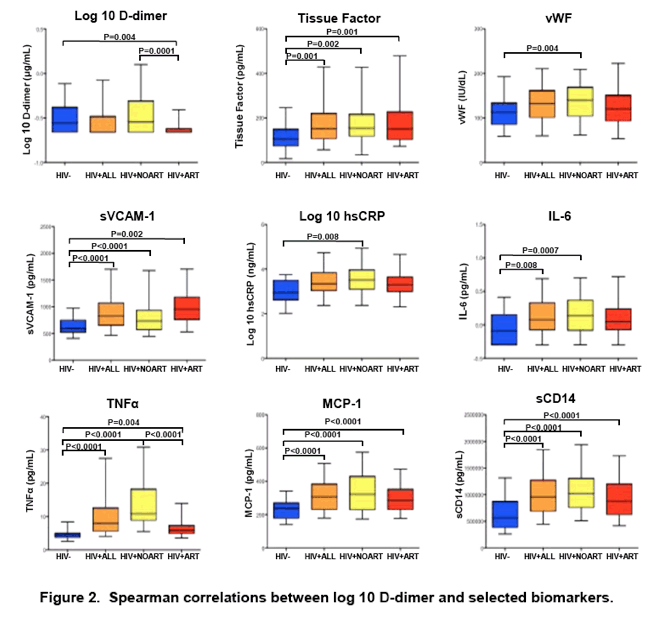
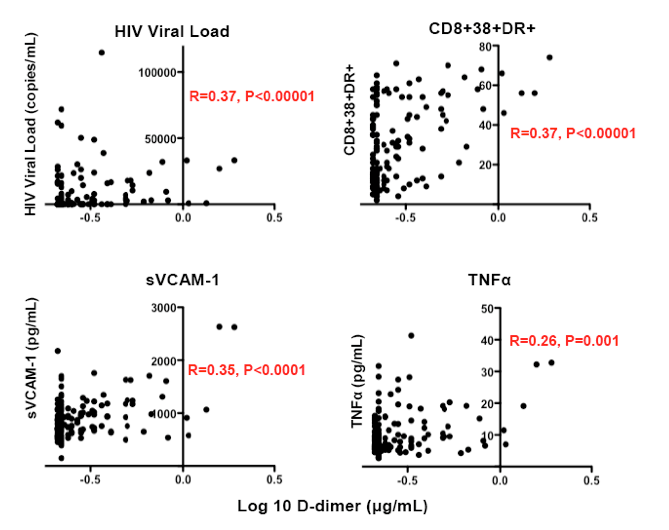
|
| |
|
 |
 |
|
|